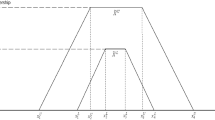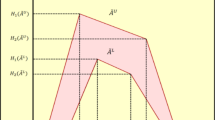Abstract
The selection of transshipment and handling machinery in container terminals is a complex and responsible task due to a number of daily operations required. Accordingly, there is a need to manage a circular economy that integrates economic parameters and attitudes toward the environment. Depending on the size of the container terminal itself, a necessary set of means for performing transshipment and handling operations is designed. In this paper, based on the previously identified needs of the IRT Belgrade container terminal, the evaluation and selection of a reach stacker within large-scale group decision making under fuzzy environment was performed. The main goal of the paper is to create an adequate fuzzy group multi-criteria decision making (MCDM) model based on the integration of Fuzzy FUCOM (Full Consistency Method), Fuzzy MARCOS (Measurement of alternatives and ranking according to COmpromise solution) and Fuzzy Bonferroni Mean (BM) operator. It was formed a total of 15 criteria divided into three basic groups: economic, technological and technical, which were evaluated on the basis of 18 experts. To determine the weight values of the criteria, the Fuzzy FUCOM method was applied through a total of 72 models averaged using the Fuzzy BM operator. Evaluation and selection of a reach stacker (RS) was performed using the Fuzzy MARCOS method and the Fuzzy BM operator. The obtained results have shown that the most important group of criteria in group decision making and processing of a larger set of data is the technological group. The best option is the seventh variant, and thus the requirement to select RS for the container terminal is met. The verification of the obtained results was performed through the following phases: the influence of the reverse rank fuzzy matrix, simulation of the weight values of the criteria through 50 formed scenarios and comparison with two other MCDM methods in a fuzzy form.










Similar content being viewed by others
References
Mańkowska M, Kotowska I, Pluciński M (2020) Seaports as nodal points of circular supply chains: opportunities and challenges for secondary ports. Sustainability 12(9):3926
Cobo PT (2018) Optimization of yard operations in container terminals from an energy efficiency approach: Ph.D. thesis, Universitat Politècnica de Catalunya
Rajahonka M, Bask A, Yawar SA, Tinnilä M (2019) The physical internet as enabler of new business models enhancing greener transports and the circular economy. In: Sustainable and Efficient Transport. Edward Elgar Publishing, Cheltenham
Cerreta M, di Girasole G, Poli E, Regalbuto S (2020) Operationalizing the Circular City model for Naples’ City-Port: A hybrid development strategy. Sustainability 12(7):2927
Makarova I, Shubenkova K, Mavrin V, Mukhametdinov E, Boyko A, Almetova Z, Shepelev V (2020) Features of logistic terminal complexes functioning in the transition to the circular economy and digitalization. Modelling of the Interaction of the Different Vehicles and Various Transport Modes. Springer, Cham, pp 415–527
Park N-K, Dragović B (2009) A study of container terminal planning. FME Trans 37(4):203–209
Yang C, Wang X, Li Z (2012) An optimization approach for coupling problem of berth allocation and quay crane assignment in container terminal. Comput Ind Eng 63(1):243–253
Said GAE-NA, El-Horbaty E-SM (2015) An optimization methodology for container handling using genetic algorithm. Procedia Comput Sci 65:662–671
Jonker T, Duinkerken MB, Yorke-Smith N, de Waal A, Negenborn RR (2019) Coordinated optimization of equipment operations in a container terminal. Flex Serv Manuf J. https://doi.org/10.1007/s10696-019-09366-3
Jin Z, Li N, Xu Q, Bian Z (2018) Modern heuristics of MCDM for the operation optimization in container terminals. Multi-Criteria Decision Making in Maritime Studies and Logistics. Springer, Cham, pp 271–322
Bruzzone A, Longo F, Nicoletti L, Bottani E, Montanari R (2012) Simulation, analysis and optimization of container terminals processes. Int J Model Simul Sci Comput 3:1–20
Muravev D, Hu H, Rakhmangulov A, Mishkurov P (2020) Multi-agent optimization of the intermodal terminal main parameters by using AnyLogic simulation platform: Case study on the Ningbo-Zhoushan Port. Int J Inf Manag :102133. https://doi.org/10.1016/j.ijinfomgt.2020.102133
Yan B, Zhu X, Wang L, Chang Y (2018) Integrated scheduling of rail-mounted gantry cranes, internal trucks and reach stackers in railway operation area of container terminal. Transp Res Rec 2672(9):47–58
Vis IFA, Harika I (2004) Comparison of vehicle types at an automated container terminal. OR Spectrum 26(1):117–143. doi:https://doi.org/10.1007/s00291-003-0146-2
Blagojević A, Vesković S, Kasalica S, Gojić A, Allamani A (2020) The application of the fuzzy AHP and DEA for measuring the efficiency of freight transport railway undertakings. Oper Res Eng Sci Theory Appl 3(2):1–23
Đalić I, Ateljević J, Stević Ž, Terzić S (2020) An integrated SWOT–Fuzzy PIPRECIA model for analysis of competitiveness in order to improve logistics performances. Facta Univ Ser Mech Eng 18(3):439–451
Vesković S, Stević Ž, Stojić G, Vasiljević M, Milinković S (2018) Evaluation of the railway management model by using a new integrated model DELPHI-SWARA-MABAC. Decis Making Appl Manag Eng 1(2):34–50
Milosavljević M, Bursać M, Tričković G (2018) Selection of the railroad container terminal in Serbia based on multi criteria decision making methods. Decis Making: Appl Manag Eng 1(2):1–15
Zečević S, Tadić S, Krstić M (2017) Intermodal transport terminal location selection using a novel hybrid MCDM model. Int J Uncertain Fuzz Knowl-Based Syst 25(06):853–876
Kadaifci C, Asan U, Serdarasan S, Arican U (2019) A new rule-based integrated decision making approach to container transshipment terminal selection. Marit Policy Manag 46(2):237–256
Krstić M, Tadić S, Brnjac N, Zečević S (2019) Intermodal terminal handling equipment selection using a fuzzy multi-criteria decision-making model. Promet-Traffic&Transportation 31(1):89–100
Celik E, Akyuz E (2018) An interval type-2 fuzzy AHP and TOPSIS methods for decision-making problems in maritime transportation engineering: the case of ship loader. Ocean Eng 155:371–381
Vesković S, Milinković S, Abramović B, Ljubaj I (2020) Determining criteria significance in selecting reach stackers by applying the fuzzy PIPRECIA method. Oper Res Eng Sci: Theory Appl 3(1):72–88
Marković V, Stajić L, Stević Ž, Mitrović G, Novarlić B, Radojičić Z (2020) A novel integrated subjective-objective mcdm model for alternative ranking in order to achieve business excellence and sustainability. Symmetry 12(1):164
Pamucar D (2020) Normalized weighted Geometric Dombi Bonferoni Mean Operator with interval grey numbers: Application in multicriteria decision making. Rep Mech Eng 1(1):44–52
Alias FMA, Abdullah L, Gou X, Liao H, Herrera-Viedma E (2019) Consistent fuzzy preference relation with geometric Bonferroni mean: a fused preference method for assessing the quality of life. Appl Intell 49(7):2672–2683
Pamucar D, Ecer F (2020) Prioritizing the weights of the evaluation criteria under fuzziness: the fuzzy full consistency method–FUCOM-F. Facta Univ Ser: Mech Eng 18(3):419–437
Xu D, Ren J, Dong L, Yang Y (2020) Portfolio selection of renewable energy-powered desalination systems with sustainability perspective: A novel MADM-based framework under data uncertainties. J Clean Prod 275:124114
Stanković M, Stević Ž, Das DK, Subotić M, Pamučar D (2020) A new fuzzy MARCOS method for road traffic risk analysis. Mathematics 8(3):457
Vis IF (2006) A comparative analysis of storage and retrieval equipment at a container terminal. Int J Prod Econ 103(2):680–693
Mitrović Simić J, Stević Ž, Zavadskas EK, Bogdanović V, Subotić M, Mardani A (2020) A novel CRITIC-Fuzzy FUCOM-DEA-Fuzzy MARCOS model for safety evaluation of road sections based on geometric parameters of road. Symmetry 12:2006
Petrović G, Mihajlović J, Ćojbašić Ž, Madić M, Marinković D (2019) Comparison of three fuzzy MCDM methods for solving the supplier selection problem. Facta Univ Ser: Mech Eng 17(3):455–469
Nedeljković M, Puška A, Doljanica S, Virijević Jovanović S, Brzaković P, Stević Ž, Marinkovic D (2021) Evaluation of rapeseed varieties using novel integrated fuzzy PIPRECIA–Fuzzy MABAC model. PloS One 16(2):e0246857
Durmić E, Stević Ž, Chatterjee P, Vasiljević M, Tomašević M (2020) Sustainable supplier selection using combined FUCOM–Rough SAW model. Rep Mech Eng 1(1):34–43
Pamucar D, Deveci M, Canıtez F, Bozanic D (2020) A fuzzy full consistency method-Dombi-Bonferroni model for prioritizing transportation demand management measures. Appl Soft Comput 87:105952
Sałabun W, Urbaniak K (2020) A new coefficient of rankings similarity in decision-making problems. In: International Conference on Computational Science. Springer, Cham, pp 632-645
Wu J, Zhao Z, Sun Q, Fujita H (2021) A maximum self-esteem degree based feedback mechanism for group consensus reaching with the distributed linguistic trust propagation in social network. Inf Fusion 67:80–93. https://doi.org/10.1016/j.inffus.2020.10.01
Capuano N, Chiclana F, Herrera-Viedma E, Fujita H, Loia V (2019) Fuzzy Group Decision Making for influence-aware recommendations. Comput Hum Behav 101:371–379. DOI:https://doi.org/10.1016/j.chb.2018.11.001
Sun Q, Wu J, Chiclana F, Fujita H, Herrera-Viedma E. A dynamic feedback mechanism with attitudinal consensus threshold for minimum adjustment cost in group decision making. IEEE, New Yoek
Author information
Authors and Affiliations
Contributions
“Conceptualization, S.V. and D.M.; methodology, Ž.S. and S.M.; validation, Ž.S. and Z.N.; investigation, S.V. and S.M.; data curation, S.V. and D.M.; writing-original draft preparation, Ž.S. and S.M.; writing-review and editing, S.V. and Z.N.; All authors have read and agreed to the published version of the manuscript.”
Corresponding author
Ethics declarations
Conflict of interest
The authors declare no conflict of interest.
Additional information
Publisher’s Note
Springer Nature remains neutral with regard to jurisdictional claims in published maps and institutional affiliations.
This article belongs to the Topical Collection: Big Data-Driven Large-Scale Group Decision Making Under Uncertainty.
Rights and permissions
About this article
Cite this article
Vesković, S., Stević, Ž., Nunić, Z. et al. A novel integrated large-scale group MCDM model under fuzzy environment for selection of reach stacker in a container terminal. Appl Intell 52, 13543–13567 (2022). https://doi.org/10.1007/s10489-021-02914-1
Received:
Accepted:
Published:
Issue Date:
DOI: https://doi.org/10.1007/s10489-021-02914-1




